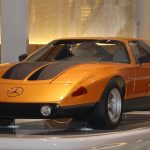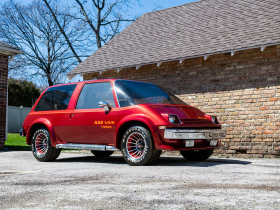During the 1970s, Mercedes-Benz experimented with many engine and aerodynamics ideas. Many of those were conducted with the C-111 prototypes. There were sixteen C-111s produced over that decade of experimentation.
The first appeared in 1969. It had a fiberglass shell into which a mid-mounted, three-rotor, direct fuel-injected Wankel rotary engine (called “M950F”) was placed. A year later, a more balanced four-rotor Wankel was put into the car, producing about 350 horsepower, allowing the car to reach up to 186 mph. Several iterations of the Wankel option were tried to find the right combination of engine power and balance for the car.
The Wankel, however, proved too difficult to work with for Mercedes’ needs, and so the next C-111 tried diesel engines instead. Dubbed the C111-IID, this one made 188 horsepower from an engine based on the 240D W115 OM616 model. Another diesel was made from the straight-five, turbocharged OM617 engine (228 hp) as the C111-III.
The C111-III had more aerodynamic bodywork, with a drag coefficient of 0.191. It broke diesel and gasoline speed records with a Nardo Ring speed of 200 mph in 1978. Its average efficiency was 16L/100km at 316 km/h. A later version of the car, equipped with a 4.8-liter turbocharged V8 beat that top speed at 251 mph a year later.
In all, the sixteen C-111 models made were made and shown or tested during the 1970s. There were thirteen Wankel models in all, some for show and some for testing. The two diesel engine models, both of which were used on the Nardo Ring. And a V8-engined gasoline model also tested at the Nardo.
The C-111 finished its course after the final 1979 model was tested. In 1991, a C112 model was introduced by Mercedes-Benz at the Frankfurt Motor Show as a potential production sports car. Its design was heavily influenced by the first-generation C-111. The W12-powered C112 was never produced.
Most of the prototyp C-111 models were scrapped. Mercedes-Benz still retains the C-111-II (Wankel-powered), and the C-111-III and IV (diesel record-breaking models) in its museum.











